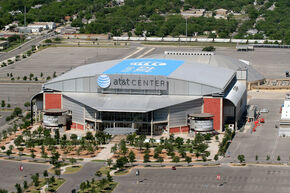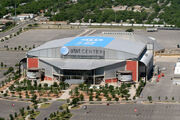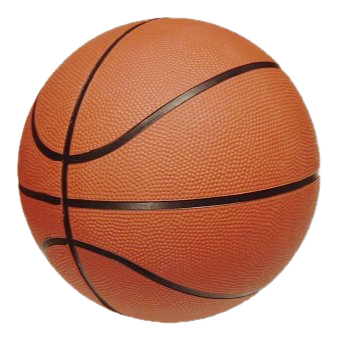 Arial view of the arena entrance. | ||
| Location: | 1 AT&T Center Parkway San Antonio, Texas 78219 | |
| Former names: | SBC Center (2002–2006) AT&T Center (2006–2023) | |
| Owner: | Bexar County | |
| Operator: | Spurs Sports and Entertainment | |
| Capacity: | 18,418 | |
| Construction information | ||
|---|---|---|
| Broke ground: | August 24, 2000 | |
| Opened: | October 18, 2002 | |
| Cost: | $186 million | |
| Tenants | ||
| San Antonio Spurs (NBA) (2002–present) San Antonio Stars (WNBA) (2003–2014, 2016-present) | ||
| Floor design | ||

| ||

A photo of the AT&T Center.
Frost Bank Center (formerly AT&T Center and SBC Center) is an indoor arena located on the east side of San Antonio, Texas. It is the home of the San Antonio Spurs of the National Basketball Association.
The arena seats 18,418 for basketball, and 19,000 for concerts or gatherings, and contains 2,018 club seats, 50 luxury suites and 32 bathrooms. It was opened in 2002 as the SBC Center, at a cost of US$175 million, financed by county-issued bonds, which were supported by a hotel-occupancy and car-rental tax increase and an additional contribution of $28.5 million from the Spurs. SBC Communications, Inc., purchased the naming rights to the facility under a 20-year, $41 million naming rights agreement with Bexar County, the San Antonio Spurs, and the San Antonio Stock Show & Rodeo in July 2000. SBC Communications changed its name to AT&T Inc. in November 2005. The arena officially changed its name to AT&T Center in January 2006. On July 2, 2021, it was announced that AT&T will not renew its contract for the name at the venue, meaning that a new name could come soon as the deal ends in fall 2022, in the 2022 offseason after failing to find a new naming rights sponsor partner following AT&T's decision not to re-new their naming rights to the arena the Spurs decided to retain the name of the arena in the 2022-23 season. On August 3, 2023, the arena was officially named Frost Bank Center.
From 2003 to 2017, the arena was home to the San Antonio Stars of the Women's National Basketball Association. It was the home of the San Antonio Rampage of the American Hockey League from 2002 until 2020.
Planning[]
Previously, the Spurs played at the football-intended Alamodome, a multi-purpose facility with a configuration that allowed half the floor space to be used for basketball. Although the Alamodome was still relatively new (opening in 1993), it had become clear over the years that the Spurs were using the dome for much of the year, making it difficult to schedule contiguous dates for conventions or even a regular-season football schedule. Although seating capacity in the Alamodome made the facility one of the largest in the NBA, the Spurs and fans were not satisfied with the facility because of its poor sight lines for basketball and the cavernous nature of the arena configuration. Being primarily a football stadium differentiated the Alamodome from most other NBA facilities, including the Spurs' previous home HemisFair Arena. The Spurs management always considered the Alamodome a temporary, not permanent solution and if a new arena deal had not be made the team most certainly would have left the city.
Additionally, since the Alamodome opened there had been a plethora of new arena construction including facilities such as Conseco Fieldhouse, which in addition to offering an intimate atmosphere offered teams several new revenue generating opportunities including suites located on the lower levels as well as large club level seating areas.
The Spurs campaigned for several years for a new facility. The Spurs and the city had come to an agreement to build a new facility adjacent to the Alamodome, but in a last-minute reversal, the team partnered with Bexar County to construct a new arena adjacent to the Freeman Coliseum. As a part of the agreement the facility would be home to both the Spurs, a new hockey team and the San Antonio Stock Show & Rodeo Association's annual, multi-day event.
The facility would be funded through an increase of hotel and car rental taxes, and Bexar County voters approved the plan in November 1999. Coincidentally, the election was held on the same day the Spurs received their NBA Championship rings for their 1999 championship title.
Construction[]
After the arena referendum passed, planning quickly began for construction on the new facility. Naming rights were obtained in July 2000 when an agreement was reached with San Antonio-based SBC Communications to name the new arena the SBC Center. The agreement was reported to be for a total of $41 million over 20 years.
Ground was officially broken on the facility in August 2000. The arena's basic design was similar to many of the other newer arenas in the NBA, in no small part to the choice of Minneapolis, Minnesota-based Ellerbe Becket as the primary architects. A nationally recognized, local architecture firm, Lake/Flato, was teamed with Ellerbe Becket to work on the design of the structure. Lake/Flato is responsible for introducing a South Texas vernacular to the overall look of the arena. Ellerbe Becket was responsible for the Conseco Fieldhouse design as well as the Washington Wizards' Verizon Center.
Memorable Moments[]
The Spurs began playing at the AT&T Center during the 2002-2003 NBA season, a season which saw the team win their second NBA Championship, defeating the New Jersey Nets in six games. The championship-clinching Game 6 was played in front of the sold-out AT&T Center crowd, who saw their Spurs rally for a 19-0 run in the fourth quarter to beat the Nets 88-77 and to send local favorite David Robinson out in style, ending his career on a championship note.
The following season saw the Spurs locking horns with their longtime nemesis, the Los Angeles Lakers, in the Western Conference semi-finals. With the series tied at two games apiece, Game 5 at the AT&T Center saw one of the most memorable finishes in NBA Playoff history. With the Spurs down by one, Tim Duncan hit a fadeaway jumper over Shaquille O'Neal to give the Spurs a one point lead with four-tenths of a second left in the game. Unfortunately for the Spurs, Derek Fisher sunk a desperation heave at the buzzer to give the Lakers the controversial victory. The Lakers would go on to win the series and eventually advance all the way to the NBA Finals, only to be bounced by Larry Brown and the Detroit Pistons in five games.
Game 7 of the 2005 NBA Finals, the first Finals Game 7 in the NBA since 1994, was played at the AT&T Center, where the Spurs beat the Detroit Pistons 81-74 to win their second title in three years, both of which were clinched at the AT&T Center.
The Coyote[]
The Spurs mascot "The Coyote" has had his share of attention at the SBC/AT&T Center. In February 2004, the original actor behind the costume, Tim Derk, suffered a stroke that left him slightly paralyzed, meaning that he could no longer perform the physically taxing task of being the Coyote. At the Spurs first home game since that incident, the Coyote, portrayed by a replacement actor, came out and performed his usual act as normal, but after his first appearance that night, he held up a sign that read "Get Well Tim Derk", which sent the 18,000+ crowd into a long standing ovation. (Derk currently continues his work with the Spurs, though not as the Coyote.) On a lighter note, on March 16, 2005, The Coyote got ejected from a game when he "argued" a call, on the baseline. The ejection was mentioned on TV and on the radio, but there was no announcement made by the PA announcer, leaving fans wondering why the Coyote wasn't appearing during timeouts. A few games later, the Coyote was given a full "pardon" by Texas Governor Rick Perry.
Since their move into the AT&T Center, the Spurs have been a tough team to play at home. As of May 23, 2006, they have compiled a home record of 164-36 in regular season and playoff games, a winning percentage of 82 percent.
